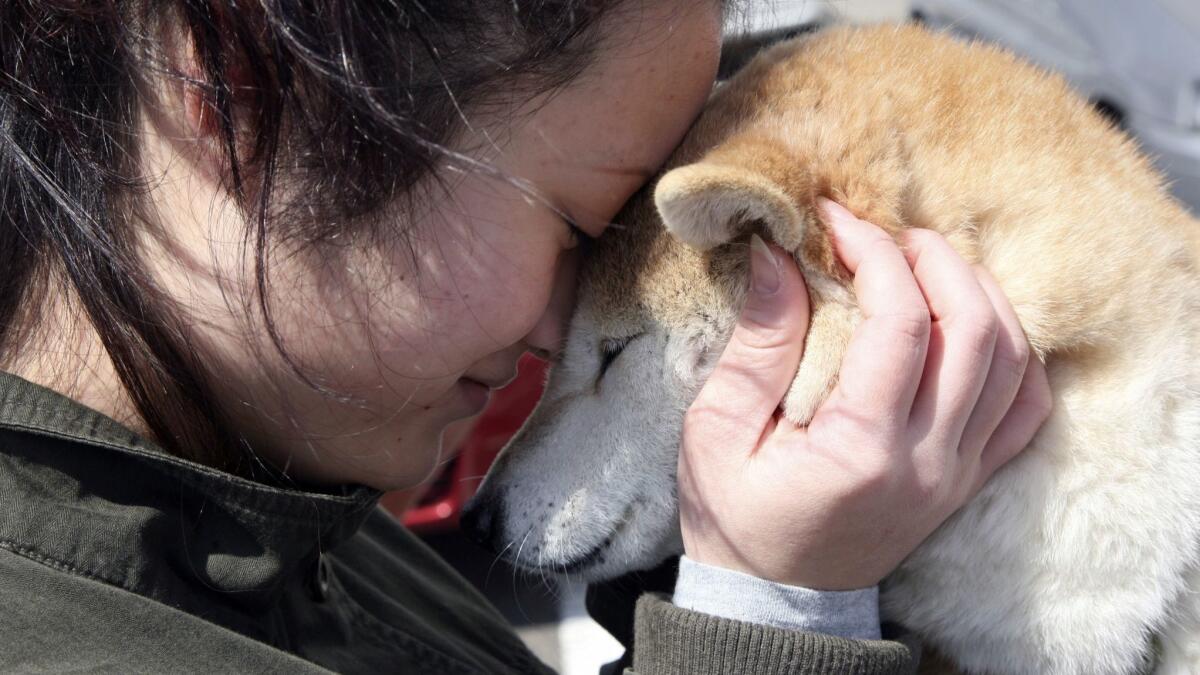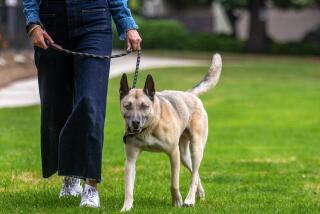Coming home stressed? Your dog is internalizing those bad vibes too, study suggests

Is your dog stressed out? Maybe you’re the one who needs a belly rub.
New research finds that throughout a dog’s life, the stress levels of a canine and his or her human tend to rise and fall together. In fact, stress in a dog appears to be more closely linked to the stress of its owner than it to the dog’s own temperament.
In the 15,000 years that humans and dogs have lived together, dependence and mutual affection have deepened our bond. And science has long established that “emotional contagion” between us and our canine pets is very real.
The new study, published Thursday in the journal Scientific Reports, is the first to find that this contagion is not fleeting. It also suggests that a dog owner’s mental well-being shapes the pet’s emotional health in a uniquely powerful way.
Much has been made of the health benefits that dogs offer to humans. Our heart rates and blood pressure routinely decline in their presence. Our levels of circulating oxytocin — often referred to as the “love hormone” — rise when we gaze into a dog’s eyes. Probably because they walk more, and also socialize more, dog owners live longer and healthier lives than those without a canine companion.
But the latest research demonstrates the extent to which that psychological connection is a two-way street. Return from work in a consistently foul mood and even if you don’t actually kick the dog — please don’t! — your furry friend’s stress level is likely to rise accordingly.
Researchers recruited 33 Shetland sheepdogs and 25 border collies and measured levels of the stress hormone cortisol in their hair and the hair of their human guardians. Unlike cortisol levels in the bloodstream, levels in hair don’t vary widely over a day, week or month. Since it builds up slowly, it offers a clearer picture of stress levels over time.
The research team from the University of Linkoping in Sweden also had each participating dog owner — all of whom were women — complete a battery of questionnaires that measured not only their own personality traits, but the temperament of their dogs.
When the study authors looked for alignment between the temperaments of dog owners and their pets, they found no significant similarities or differences. There was little to suggest either that humans “pick” dogs that match their personalities, or that, like the stereotypical old married couple, they grow more similar over time.
But when the researchers examined the hair samples, they found clear evidence of emotional convergence between dog and human.
Taken once in summer and once in winter to account for seasonal variability, cortisol concentrations tended to be high in the sheepdogs and collies when their human guardians’ levels were also high. And this key measure of chronic stress was lower in dogs whose owners’ hair samples indicated lower levels of chronic stress.
The big surprise came when the researchers looked for a link between dogs’ cortisol levels and their personalities (as reported by their owners — yes, these exist).
If a pet parent described her pooch as timid, fearful or anxious, the researchers expected they might find higher cortisol levels in the dog’s hair samples, and to find lower concentrations in samples from confident, easygoing dogs, according to Lina S.V. Roth, the paper’s senior author (and owner of a dog named Trixie).
But they didn’t. Canine cortisol levels did not seem to rise and fall with their position on the temperamental spectrum from fearful to calm. The cortisol levels of their humans were actually a much better predictor of a dog’s stress level.
That, the researchers wrote, suggests that “it is the dogs that mirror the stress levels of their owners rather than the owners responding to the stress in their dogs.”
Brian Hare, a Duke University professor of evolutionary biology and expert in animal cognition, cautioned that the findings show only an association at this point. While provocative and original, the new research will need to take some further steps to show that an owner’s stress levels are what cause stress in their dogs, he said.
But the finding delighted University of Nebraska at Omaha developmental psychologist Jonathan Santo, who co-authored a 2015 study finding clear evidence of short-term emotional contagion between dogs and their owners.
Not only did the researchers find evidence of lasting emotional synchrony between dog and human, that association was apparent in a sample of just 58 dogs and their owners, Santo said. Most human personality traits can only be clearly seen in much larger samples, he said.
“What this paper seems to hint at is some of the underlying mechanisms behind why humans and dogs or wolves have been able to domesticate each other over thousands of years,” Santo said. “We’re both social species, and once we became integrated into each other’s lives, it was to everyone’s advantage that dogs and humans would keep tabs on each other emotionally.”
Santo, who co-parents a dog with strong St. Bernard features, said he suspects that dogs’ anxieties affect their guardians’ stress levels as well. But he added: “I’m inclined to believe it’s more one way than the other. With dogs as they stand now, they are so much more dependent for their survival on humans than the other way around. It makes sense as an evolutionary strategy that they have become very sensitive to humans, and adopted properties that endear them to us.”
The new research suggests some intriguing trends for researchers to explore in the future. The stress levels of female dogs were a closer match to the stress of their owners than they were for male dogs. The same was true of dogs engaged in competitive agility and other intensive training activities compared to dogs that served strictly as companions.
And for dog owners who work outside the home or who don’t have a fenced-in space for their pets to wander unattended, the study provided some comforting news: Canine cortisol levels did not vary as a function of either condition.
Roth, a biologist who specializes in canine and equine cognition, said her group’s past research with German shepherds has found that play and similar affectionate interactions are the key factor in tamping down dogs’ anxieties. Exercise and access to green spaces are great, she said, but “if we just interact with the dog in a positive way, we do give the dog what it wants. Have fun with your dog.”
She added that follow-up studies are already planned to explore the impact of dogs’ and owners’ genders on long-term emotional synchrony, and to learn why and with whom our pets’ most powerful attachments are made. While border collies and Shetland sheepdogs are known for their friendliness and ability to be attuned to humans, other breeds and those of mixed backgrounds need to be studied as well, she said.
Dogs’ dependence on humans — not just for food and shelter but for emotional well-being — has grown pretty lopsided, Roth said. That’s why it’s important to explore the possibility that dogs’ inner lives are powerfully affected by their guardians’ mental health.
‘We are quite a central part of their world,” Roth said. “We have work, and other circles of friends. But for a dog, we are almost everything. Under those circumstances, it’s important to know, who is synchronizing with whom?”







